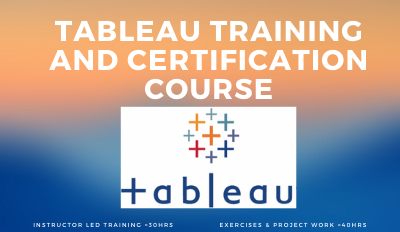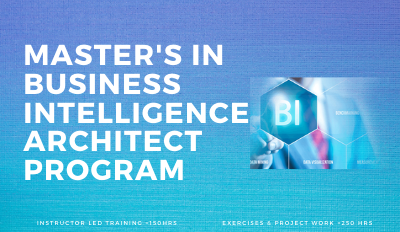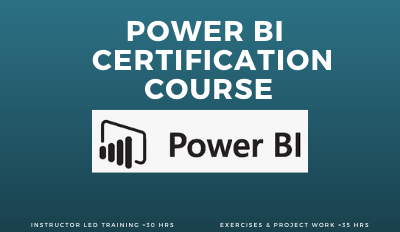

Overview
Course Description
One of the skills that characterizes great business data analysts is the ability to communicate practical implications of quantitative analyses to any kind of audience member. Even the most sophisticated statistical analyses are not useful to a business if they do not lead to actionable advice, or if the answers to those business questions are not conveyed in a way that non-technical people can understand.
In this course , you will discover what data visualization is, and how we can use it to better see and understand data. Using Tableau, we’ll examine the fundamental concepts of data visualization and explore the Tableau interface, identifying and applying the various tools Tableau has to offer. By the end of the course, you will become proficient in the concepts of filters, parameters, maps, graphs, dashboards, and table calculation. Furthermore, you will learn about data blending, data aggregation, and R connectivity with Tableau in this online Tableau course.
Course Content
Module 1 - Introduction to Data Visualization and Power of Tableau
1.1 What is data visualization?
1.2 Comparison and benefits against reading raw numbers
1.3 Real use cases from various business domains
1.4 Some quick and powerful examples using Tableau without going into the technical details of Tableau
1.5 Installing Tableau
1.6 Tableau interface
1.7 Connecting to DataSource
1.8 Tableau data types
1.9 Data preparation
Module 2 - Architecture of Tableau
2.1 Installation of Tableau Desktop
2.2 Architecture of Tableau
2.3 Interface of Tableau (Layout, Toolbars, Data Pane, Analytics Pane, etc.)
2.4 How to start with Tableau
2.5 The ways to share and export the work done in Tableau
Module 3 - Working with Metadata and Data Blending
3.1 Connection to Excel
3.2 Cubes and PDFs
3.3 Management of metadata and extracts
3.4 Data preparation
3.5 Joins (Left, Right, Inner, and Outer) and Union
3.6 Dealing with NULL values, cross-database joining, data extraction, data blending, refresh extraction, incremental extraction, how to build extract, etc.
Module 4 - Creation of Sets
4.1 Mark, highlight, sort, group, and use sets (creating and editing sets, IN/OUT, sets in hierarchies)
4.2 Constant sets
4.3 Computed sets, bins, etc.
Module 5 - Working with Filters
5.1 Filters (addition and removal)
5.2 Filtering continuous dates, dimensions, and measures
5.3 Interactive filters, marks card, and hierarchies
5.4 How to create folders in Tableau
5.5 Sorting in Tableau
5.6 Types of sorting
5.7 Filtering in Tableau
5.8 Types of filters
5.9 Filtering the order of operations
Module 6 - Organizing Data and Visual Analytics
6.1 Using Formatting Pane to work with menu, fonts, alignments, settings, and copy-paste
6.2 Formatting data using labels and tooltips
6.3 Edit axes and annotations
6.4 K-means cluster analysis
6.5 Trend and reference lines
6.6 Visual analytics in Tableau
6.7 Forecasting, confidence interval, reference lines, and bands
Module 7 - Working with Mapping
7.1 Working on coordinate points
7.2 Plotting longitude and latitude
7.3 Editing unrecognized locations
7.4 Customizing geocoding, polygon maps, WMS: web mapping services
7.5 Working on the background image, including add image
7.6 Plotting points on images and generating coordinates from them
7.7 Map visualization, custom territories, map box, WMS map
7.8 How to create map projects in Tableau
7.9 Creating dual axes maps, and editing locations
Module 8 - Working with Calculations and Expressions
8.1 Calculation syntax and functions in Tableau
8.2 Various types of calculations, including Table, String, Date, Aggregate, Logic, and Number
8.3 LOD expressions, including concept and syntax
8.4 Aggregation and replication with LOD expressions
8.5 Nested LOD expressions
8.6 Levels of details: fixed level, lower level, and higher level
8.7 Quick table calculations
8.8 The creation of calculated fields
8.9 Predefined calculations
8.10 How to validate
Module 9 - Working with Parameters
9.1 Creating parameters
9.2 Parameters in calculations
9.3 Using parameters with filters
9.4 Column selection parameters
9.5 Chart selection parameters
9.6 How to use parameters in the filter session
9.7 How to use parameters in calculated fields
9.8 How to use parameters in the reference line
Module 10 - Charts and Graphs
10.1 Dual axes graphs
10.2 Histograms
10.3 Single and dual axes
10.4 Box plot
10.5 Charts: motion, Pareto, funnel, pie, bar, line, bubble, bullet, scatter, and waterfall charts
10.6 Maps: tree and heat maps
10.7 Market basket analysis (MBA)
10.8 Using Show me
10.9 Text table and highlighted table
Module 11 - Dashboards and Stories
11.1 Building and formatting a dashboard using size, objects, views, filters, and legends
11.2 Best practices for making creative as well as interactive dashboards using the actions
11.3 Creating stories, including the intro of story points
11.4 Creating as well as updating the story points
11.5 Adding catchy visuals in stories
11.6 Adding annotations with descriptions; dashboards and stories
11.7 What is dashboard?
11.8 Highlight actions, URL actions, and filter actions
11.9 Selecting and clearing values
11.10 Best practices to create dashboards
11.11 Dashboard examples; using Tableau workspace and Tableau interface
11.12 Learning about Tableau joins
11.13 Types of joins
11.14 Tableau field types
11.15 Saving as well as publishing data source
11.16 Live vs extract connection
11.17 Various file types
Module 12 - Tableau Prep
12.1 Introduction to Tableau Prep
12.2 How Tableau Prep helps quickly combine join, shape, and clean data for analysis
12.3 Creation of smart examples with Tableau Prep
12.4 Getting deeper insights into the data with great visual experience
12.5 Making data preparation simpler and accessible
12.6 Integrating Tableau Prep with Tableau analytical workflow
12.7 Understanding the seamless process from data preparation to analysis with Tableau Prep
Module 13 - Integration of Tableau with R and Hadoop
13.1 Introduction to R language
13.2 Applications and use cases of R
13.3 Deploying R on the Tableau platform
13.4 Learning R functions in Tableau
13.5 The integration of Tableau with Hadoop
Student feedback
10 Reviews
- 9
- 0
- 0
- 0
- 0
5.0
out of 5
Course Rating
Add Reviews & Rate
Related Courses

Master's in Business Intelligence Architect Program

Maanas Purohit-

-

-

-

-

- (5.0)
March 10, 2021Great Course
The course content is good. The instructor covers all concepts which are listed on the certification exam guide published by Tableau. This course really helped me a lot. Well designed and well explained. SparkAcademy ,thanks to you!!
Poorvi Rana-

-

-

-

-

- (5.0)
March 04, 2021Amazing training
Great course! Pretty in depth and covers what you need to get a a comprehensive overview of what is possible with Tableau.
Vishal Negi-

-

-

-

-

- (4.5)
February 26, 2021Great Understanding
Easy to understand yet in-depth course. The trainer has explained all concepts and tools with examples, also the practice activities are very helpful.
Twinkle Abrol-

-

-

-

-

- (5.0)
February 17, 2021Amazing tutorials
An amazing tutorial with a detailed explanation of each feature. I've recommended you to friends, and I'd do another course with you if I needed what you offer...
Avishesh Pradhan-

-

-

-

-

- (5.0)
February 10, 2021Good Course
I really liked this course! I'm desperate to learn Tableau, and other skills, so that I may become a Data Analyst... so this is a big deal for me! It is worth your time to take this course as you can use it in various projects and avenues also. Thank you!
Rohit Baliyan-

-

-

-

-

- (5.0)
February 01, 2021Knowledgeable & Great course
Very informative and comprehensive. Thoroughly enjoyed the entire course and would recommend it to peers. Just booked my Desktop Specialist Exam and am confident to ace it with the knowledge gained. Thanks.
Garima Nagpal-

-

-

-

-

- (5.0)
January 26, 2021Amazing content
I took this course to be able to pass the Tableau Desktop Certificate Exam. having completed the course I feel it does help you do exactly that while also teaching you to use Tableau in general. Very Good content.
Niharika Anand-

-

-

-

-

- (5.0)
January 15, 2021Well structured tutorials
Great Tutorial. Very well laid out and presented. I found this course very helpful as part of my preparation for the Tablueau Desktop Specialist exam. This course was well formatted.
Radhika KIlla-

-

-

-

-

- (5.0)
January 11, 2021Perfect Course
The course was very informative and well explained will surely recommend it. It's easy to follow. Quite detailed. I enjoyed taking this course.
Pushkar Sharma-

-

-

-

-

- (5.0)
January 07, 2021Great Course
Great content and even better delivery. the course is pretty good. Examples are also great, everything is clear. Overall a great course. Must take this course!!